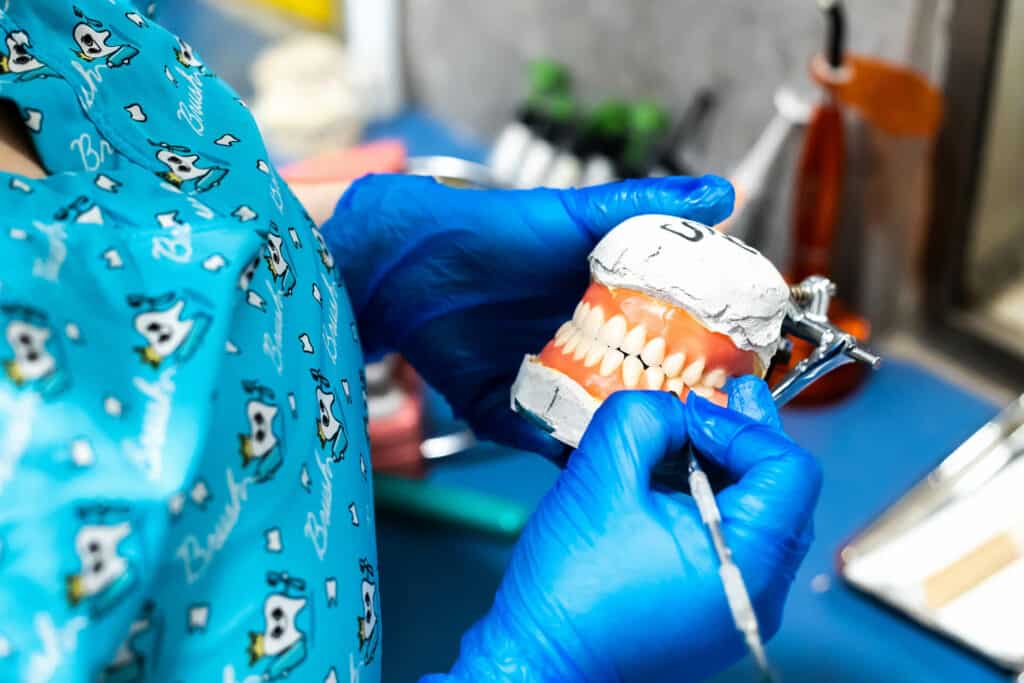The initial stages of treatment are aimed at addressing the underlying causes of your condition, which frequently requires careful instruction in effective and current plaque removal techniques. This is often coupled with thorough cleaning procedures that may include scaling of the clinical crown and root to remove plaque and tartar deposits above and below the gumline.
The tooth roots may also be planned to remove the bacterial toxins that penetrate the root surface. Once accomplished, this will allow the gum tissue to heal and reattach to the tooth. Irrigation with anti-microbial agents may be recommended to help control the growth of bacteria that create toxins and cause periodontitis.
When deep periodontal pockets developed around your teeth, it is difficult to thoroughly remove the plaque and tartar irritants below the gumline, and manage the inflammation that they cause. Patients can seldom, if ever, control the bacterial populations in these deeper sites. As a result, the disease almost invariably progresses. Consequently, surgery may be needed to eliminate the deep-seated inflammation and create the opportunity for bone regeneration, which will restore periodontal health.
Scaling & Root Planning With ARESTIN
Scaling and root planing therapy is a common treatment used for putting a stop to the progression of gum disease. It is a nonsurgical treatment that is essentially a deep cleaning of all surfaces of your teeth, both above and below the gumline. Before treatment, we first perform a thorough oral exam, which includes both a visual exam as well as dental x-rays. The exam is performed to assess the extent of your gum disease and determine if scaling and root planing is truly the best course of action.
Learn more about Scaling & Root Planning
Locally Administered Antibiotics
Although scaling and root planing (SRP) is effective at reducing plaque and some bacteria, it doesn’t kill all of the bacteria that cause periodontal disease. SRP is a mechanical procedure and the instruments used to perform SRP cannot always reach the bacteria that reside at the bottom of deep or difficult-to-reach periodontal pockets. For these pockets, we can add a locally administered antibiotic such as ARESTIN® (minocycline hydrochloride) Microspheres, 1mg to the SRP procedure.
ARESTIN® is a small amount of antibiotic powder that is placed inside infected periodontal pockets just after the hygienist finishes the SRP procedure. Once ARESTIN® is inserted, it immediately adheres to the periodontal pocket. Through a process called “polymer hydrolysis”, tiny holes in the Microspheres provide “escape routes” for the drug to be slowly released and absorbed into the surrounding gum tissue. This allows for a “sustained release” of the antibiotic, meaning ARESTIN® continues to work inside your gums for up to 21 days.
ARESTIN® may be used as part of a periodontal maintenance program, which includes good oral hygiene, and SRP. This comprehensive approach provides patients with two therapies that work simultaneously (ARESTIN® + SRP) to help kill the harmful bacteria that cause periodontal disease. Clinical studies have shown that ARESTIN® plus SRP is more effective than SRP alone at shrinking the size of infected periodontal pockets, killing the bacteria associated with periodontal disease, and reducing bleeding of the gums.
Occlusal Control—Bite Adjustment
A person’s occlusion relates to how their teeth work together in harmony for proper chewing and support of their temporomandibular joints. A bite is considered to be healthy when all or most of the teeth are present and properly aligned to distribute the pressures of the bite as uniformly as possible. When the teeth are not properly aligned or several teeth are missing, then the entire joint system must attempt to adapt to these changes. Over time, this can lead to changes in tooth position, unusual wear patterns, and fractures of dental restorations and teeth.
With progressive periodontal disease or when significant overloading of the teeth occurs, the teeth themselves can become loose inside of the supporting bone. The jaw joint attempts to adapt to these changes but is often damaged in the process.
Occlusal or bite therapy helps restore a healthy, stable bite so that pressures can be uniformly distributed throughout the dental arch. Therefore, this can significantly reduce the damage that can occur to the teeth, the supporting periodontal structures, and the jaw joints.
Occlusal or bite therapy may include:
- Reshaping the biting surfaces of the teeth and eliminating spots of excessive pressures where the teeth are brought into contact. This is done by carefully spreading bite pressures uniformly on all of the teeth.
- Utilizing a custom-fitted and carefully adjusted acrylic bite guard, we are able to keep the teeth apart at night and reduce tooth wear and trauma. Bite therapy is frequently carried out in the periodontal office, however, your family dentist may have specialized training in bite management and may also manage this component of your care.
- Orthodontic braces are often utilized to reposition mal-aligned or drifted teeth, thereby allowing the system to once again function normally. Learn more about Occlusal Control
Your restorative Doctor will concurrently participate in this portion of your care:
- Replacing old, worn out, or damaged dental fillings.
- Reconstructing badly worn, damaged, or fractured teeth.






